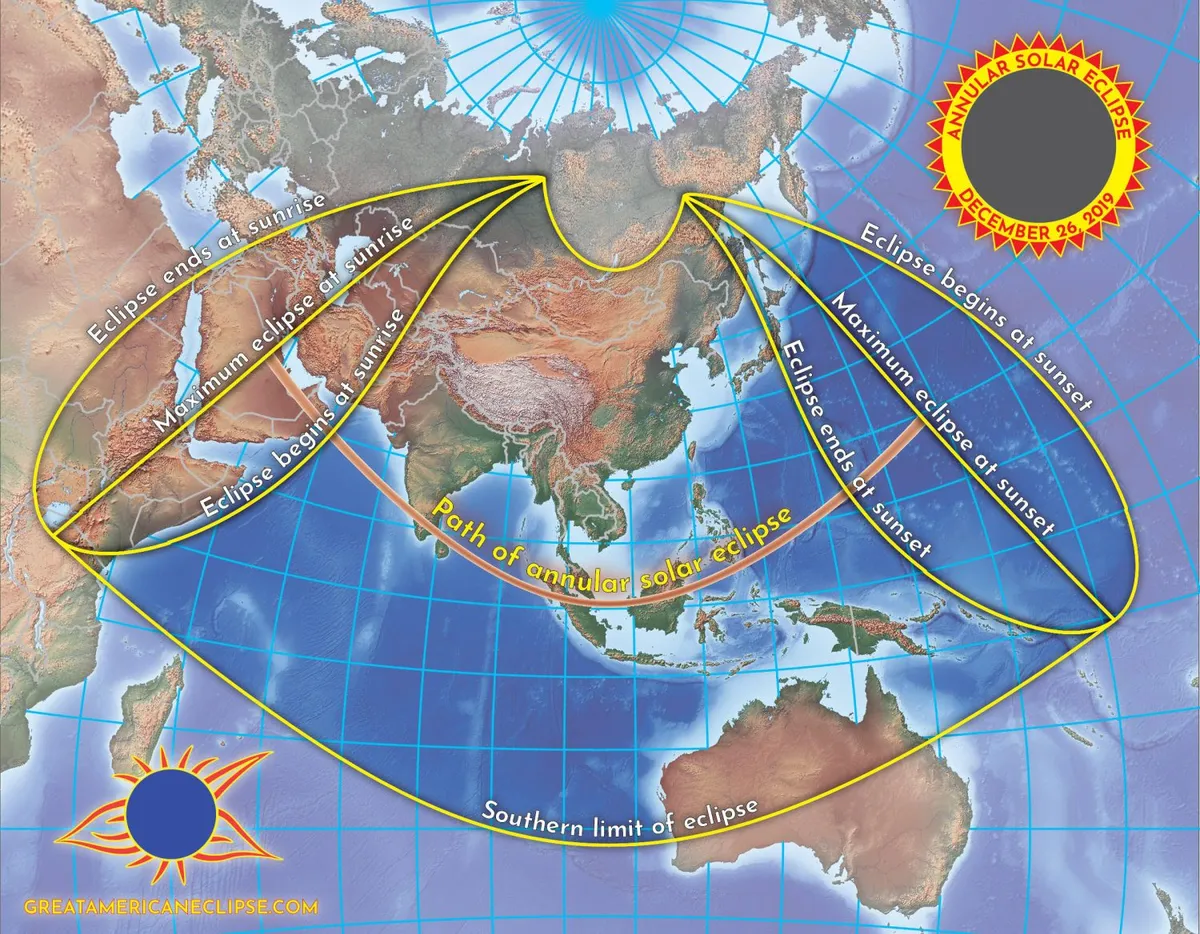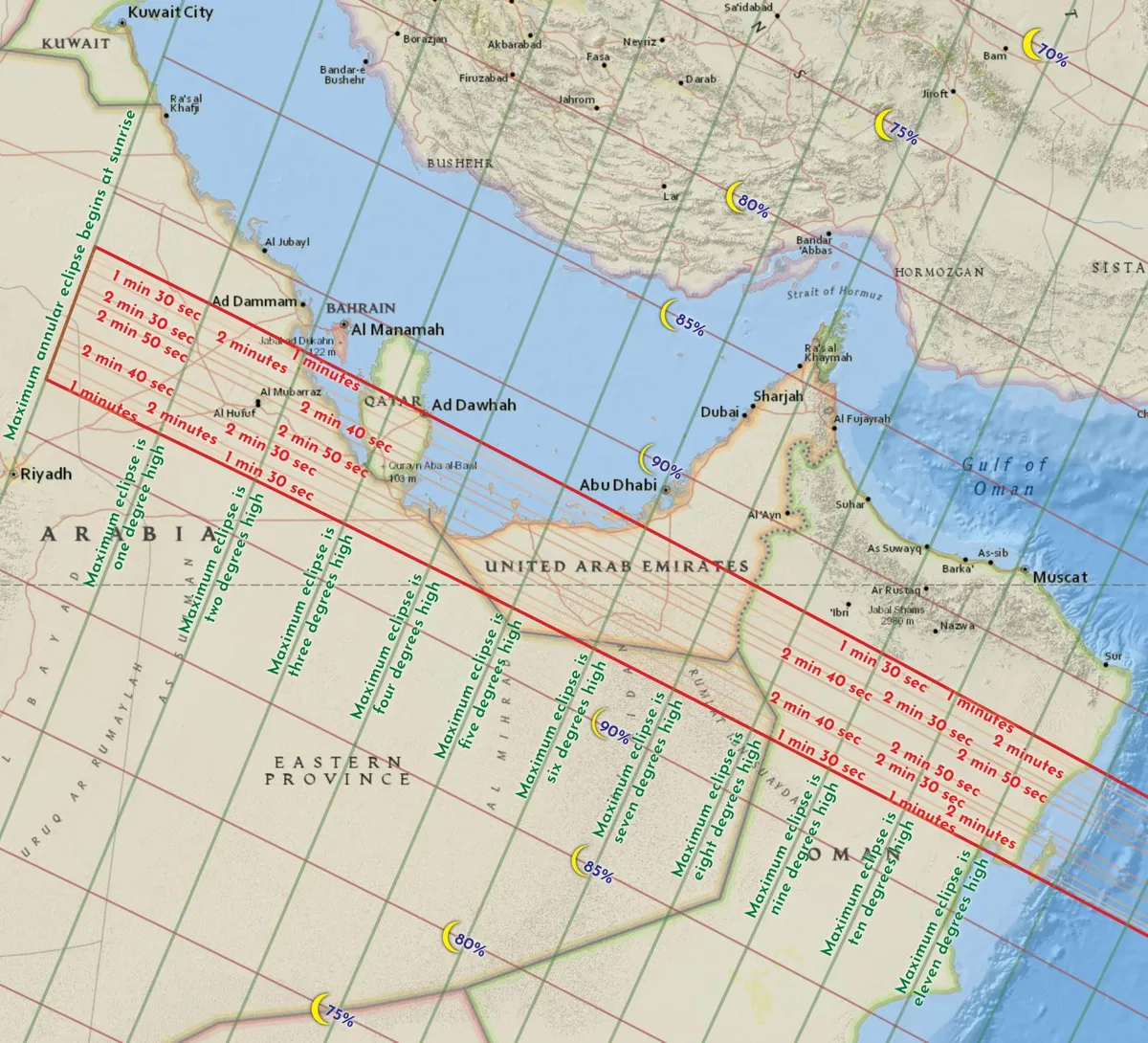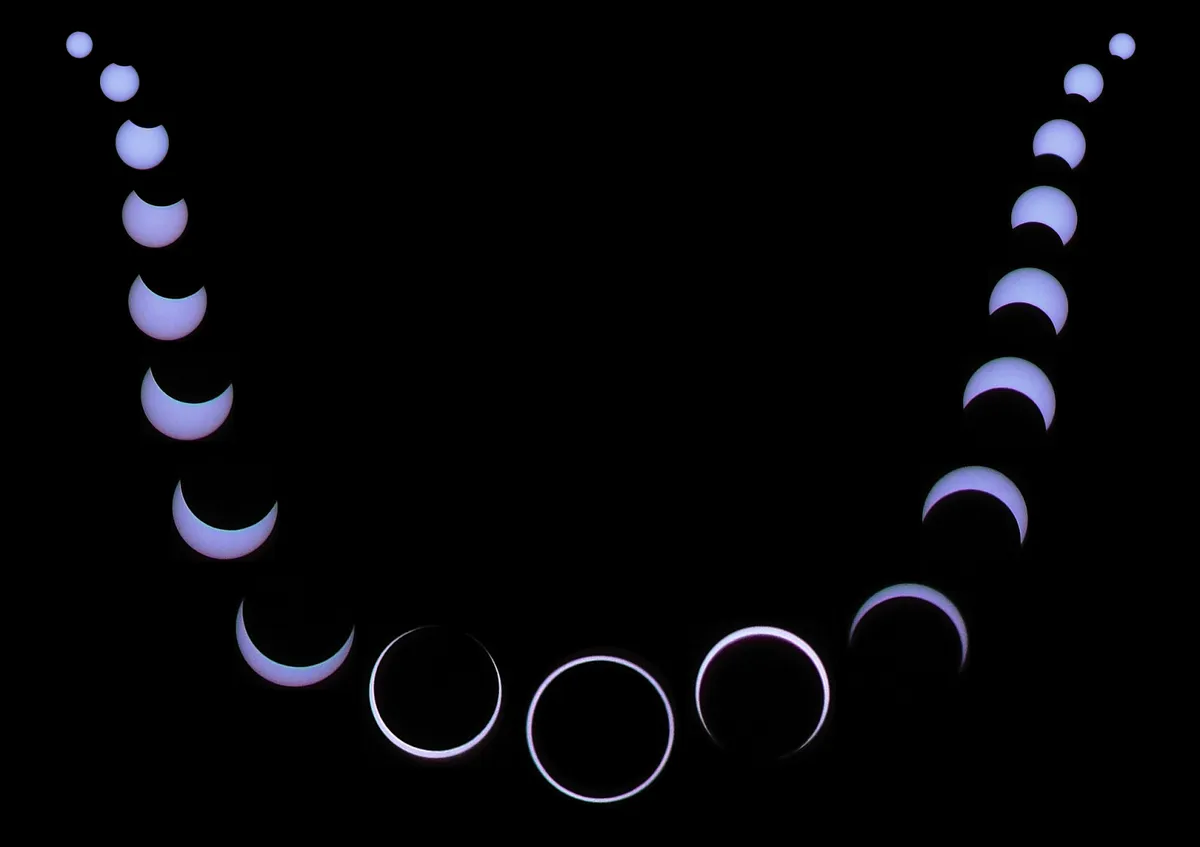It won’t equal the majesty of a total solar eclipse, but on Boxing Day 2019 the dramatic spectacle of a large annular solar eclipse will be gifted to observers in a 110km-wide path across the globe. Annular comes from ‘annulus’, the Latin word for ring, and on Thursday December 26 2019 the Sun will rise as a ‘ring of light’ (also known as a ‘ring of fire’) in an area of Saudi Arabia as the Moon covers 97% of its centre.
It will then be viewable higher in the sky from a narrow path through Qatar, the UAE, Oman, southern India, Sri Lanka, Indonesia, Singapore and Malaysia, setting east of Guam in the Pacific Ocean (here’s a fabulous interactive Google Map).
Anyone standing near the centreline of the ‘path of annularity’ will see a ring around the sun for a maximum of 3 minutes and 40 seconds.
It’s the most beautiful type of partial solar eclipse, but it’s also the most dangerous. All observers will need to wear solar eclipse glasses at all times, and attempts to photograph it will require special solar filters.
If you missed this one, the next eclipse that should be in your calendar is the solar eclipse of 10 June 2021.

What is an annular solar eclipse?
It’s not to be confused with a total solar eclipse, which occurs when a new Moon covers 100% of the Sun. During an annular solar eclipse the Moon is further away from Earth on its slightly elliptical orbit, so not big enough in our sky to cover the whole of the Sun.
On Boxing Day, those in the path of annularity will see a ring of some kind, but only those on its centreline will see a perfect circular ring.
Away from the path a regular partial solar eclipse will be visible across the Middle East, south-east Asia and Australasia.
Understanding the shadow cone
When the Moon appears to move in front of the Sun it casts a cone-shaped shadow on to Earth, but it’s the distance of the Moon from Earth that determines what part of that cone strikes Earth, and therefore what the visible effect will be.
During a total solar eclipse the point of the cone passes into the Earth, creating a ‘path of totality.
During an annular solar eclipse, the point of the cone doesn’t quite reach Earth’s surface, creating a ‘path of annularity’ instead where an unbroken ring of light is visible.
Although the solar corona is not visible during an annular solar eclipse, those who stand near the southern or northern edges of the path of annularity get a distorted view and see the edge of the Moon appear to strike the edge of the Sun.
Some careful observing by experienced eclipse-chasers can result in a fleeting view of the sun’s inner corona, its outer pink-ish chromosphere and, sometimes, beads of light coming through the Moon’s valleys, known as Baily's Beads.
Video: The last good opportunity for a sunrise annular solar eclipse was in the outback of Australia on May 10, 2013.
The best places to watch this eclipse
Most of us will have to make do with streaming this eclipse online at timeanddate.com’s Live page or Youtube channel, and NASA TV, perhaps with a turkey sandwich at hand, though for dedicated eclipse-chasers there’s really only one place to be.
Although a pretty sight through solar eclipse glasses from anywhere along the path of annularity, the prize for most eclipse-chasers will be to witness the spectacle of an eclipsed sunrise.
That will occur in Saudi Arabia, where clear skies are almost guaranteed. From there an annular solar eclipse distorted by atmospheric refraction will be visible and – if there’s sand and dust in the air – possibly viewable with the naked eye.
The ideal spot for that will be on the highway from Riyadh to Ad Damman, probably on top of sand dune towards the southern limit of the path of annularity.
However, the eclipse will take place relatively low in the sky in Qatar (about 2° to 3° above the horizon), which is a far easier place for independent travel, and the destination for many eclipse-chasers this Christmas.
Oman and the east coast of Kerala will also draw visitors, though the rest of the path goes through reliably cloudy terrain; Singapore seems like a good location, but it’s so often cloudy.

When and where are the next annular solar eclipses?
The next three annular solar eclipses after 2019 occur over exotic locations, from Ethiopia and Tibet to northern Canada and central America.
1
A solstice solar eclipse: 21 June, 2020
Next summer will see an extra-special annular solar eclipse, but not only because it’s occurring on the summer solstice.
Visible from a path across Africa and Asia, a ‘ring of light’ will be observed at sunrise in the Congo.
This one lasts a maximum of just 38 seconds from the track’s centre point Uttarakhand, northern India and, at 99%, is very nearly a total solar eclipse.
The path crosses the Congo, Democratic Republic of Congo, South Sudan, Ethiopia, Eritrea, Yemen, Oman, Pakistan, India, Tibet, China and Taiwan.
Expect the most popular spots to be south of Muscat in Oman, the rock-cut monolithic churches of Lalibela, Ethiopia and on the centre line north of Lhasa in Tibet.
2
A path for polar bears: 10 June, 2021
This is the next chance to witness a rising annular solar eclipse, though the areas of southern Canada it will be visible from - northern Ontario, northern Quebec and, more specifically, the vast Polar Bear Provincial Park - are likely to be cloudy.
Expect many aircraft to take eclipse-chasers above the forest.
Visible from a path through northern Canada, Greenland and far north-eastern Russia, the maximum annularity will be for 3 minutes and 51 seconds in uninhabited northern Greenland.
The northeastern U.S. states will get a big partial solar eclipse for breakfast.

3
An all-American annular: 14 October, 2023
The USA is in a ‘golden age’ of solar eclipses. With its ‘Great American Eclipse’ of 21 August, 2017 still fresh in the memory, in 2023 a path through Oregon, Nevada, Utah, Colorado and New Mexico will witness a 95% annular solar eclipse just six months before a ‘Great North American’ four minutes+ total solar eclipse in the U.S., Canada and Mexico on April 8, 2024.
As luck would have it, it’s going to be visible from a host of famous national parks, from Crater Lake National Park in Oregon and Great Basin National Park in Nevada to Utah’s Canyonlands National Park, Natural Bridges National Park, Capitol Reef National Park and Bryce Canyon National Park.
The path also passes through Mexico (including the Yucatán peninsula’s famous Edzná Maya temples), Belize, Honduras, Nicaragua, Panama, Colombia and Brazil.
The maximum annularity will be 5 minutes 17 seconds from just off the coasts of Costa Rica and Nicaragua.
